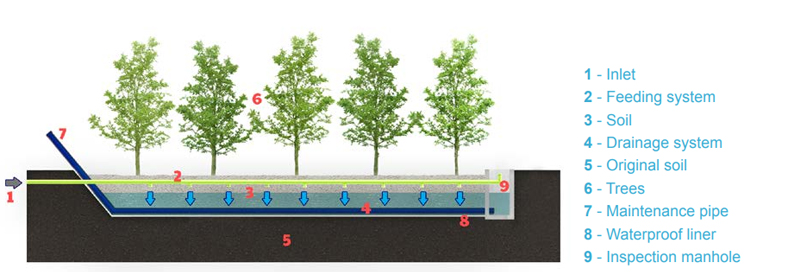- Mitigation title
- Willow wetland systems
-

- Description
-
As the name suggests willow systems are wetlands dominated by willows. They are also a form of Short Rotation Coppice. They are designed to treat all inflow water through evapotranspiration and therefore there is no outflow from the system. Although they have the capability of being compatible with other systems.
As they produce high biomass, it has the potential to create a new energy/economy stream.
- Advantages
-
- Can be fed by gravity (low energy use)
- Biodiversity enhancement
- Carbon sequestration
- Flood mitigation
- Supports pollination
- Disadvantages
-
- Impacted by climate conditions
- Biomass has to be removed
- Parameters
-
- Phosphorus
- Ammonia
- Nitrogen
- BOD/COD
- Suspended solids
- Carbon footprint
-
- Short term energy requirements for earth works
- Acts as a net carbon sink
- Time to become effective
-
- Removal of nutrients / organic matter will first need willow to become established
- Maintenance
-
- Biomass harvesting is essential. At least half to one third of the system must be harvested every 2-4 years
- Performance with time
-
- Initial performance will be poor but will increase as willow grows
- Performance can be kept at optimum with well a well-established maintenance schedule
- Performance fluctuates with seasonal changes; lower in autumn/winter, highest in spring/summer
- Performance fluctuates dependent on growing season
- Scaling considerations
-
The size of the willow system is correlated to the load of nutrient removal, but often requires large land areas to be an effective site. Design criteria to meet:
- Monitoring required of the concentrations and a Population Equivalent must be evidenced
- Mass loading will directly impact sizing, aspect ratio, and depth
- Must take into account climate factors and climate change, such as droughts and dry weather, or water gains from rainfall, etc. As well seasonal dynamics and differences in flows through different seasons
- Must take into account seasonal efficiency tied to plant growth
- References
-
H. Rosenqvist, P. Aronsson, K. Hasselgren, K. Perttu. (1997). Economics of using municipal wastewater irrigation of willow coppice crops. Biomass and Bioenergy.
Hänel, M.; Istenič, D.; Brix, H.; Arias, C.A. (2022). Wastewater-Fertigated Short-Rotation Coppice, a Combined Scheme of Wastewater Treatment and Biomass Production: A State-of-the-Art Review. Forest.
ICRA. (n.d.). Willow Systems. Retrieved from https://snapp.icra.cat/factsheets/03_Willow%20systems.pdf
Khurelbaatar, G.; van Afferden, M.; Sullivan, C.M.; Fühner, C.; Amgalan, J.; Londong, J.; Müller, R.A. (2021). Wastewater Treatment and Wood Production of Willow System in Cold Climate. Water.
Ricardo for Herefordshire Council. (2021). Interim Phosphate Delivery Plan Stage 2, Mitigation options for phosphate removal in the Wye Catchment.
S. O'Hogain, L. McCarton, A. Reid, J. Turner, S. Fox. (2011). A review of zero discharge wastewater treatment systems using reed willow bed combinations in Ireland. Water Practice and Technology.
Xavier Lachapelle-T., M. L. (2019). Treatment and valorization of a primary municipal wastewater by a short rotation willow coppice vegetation filter. Ecological Engineering.
